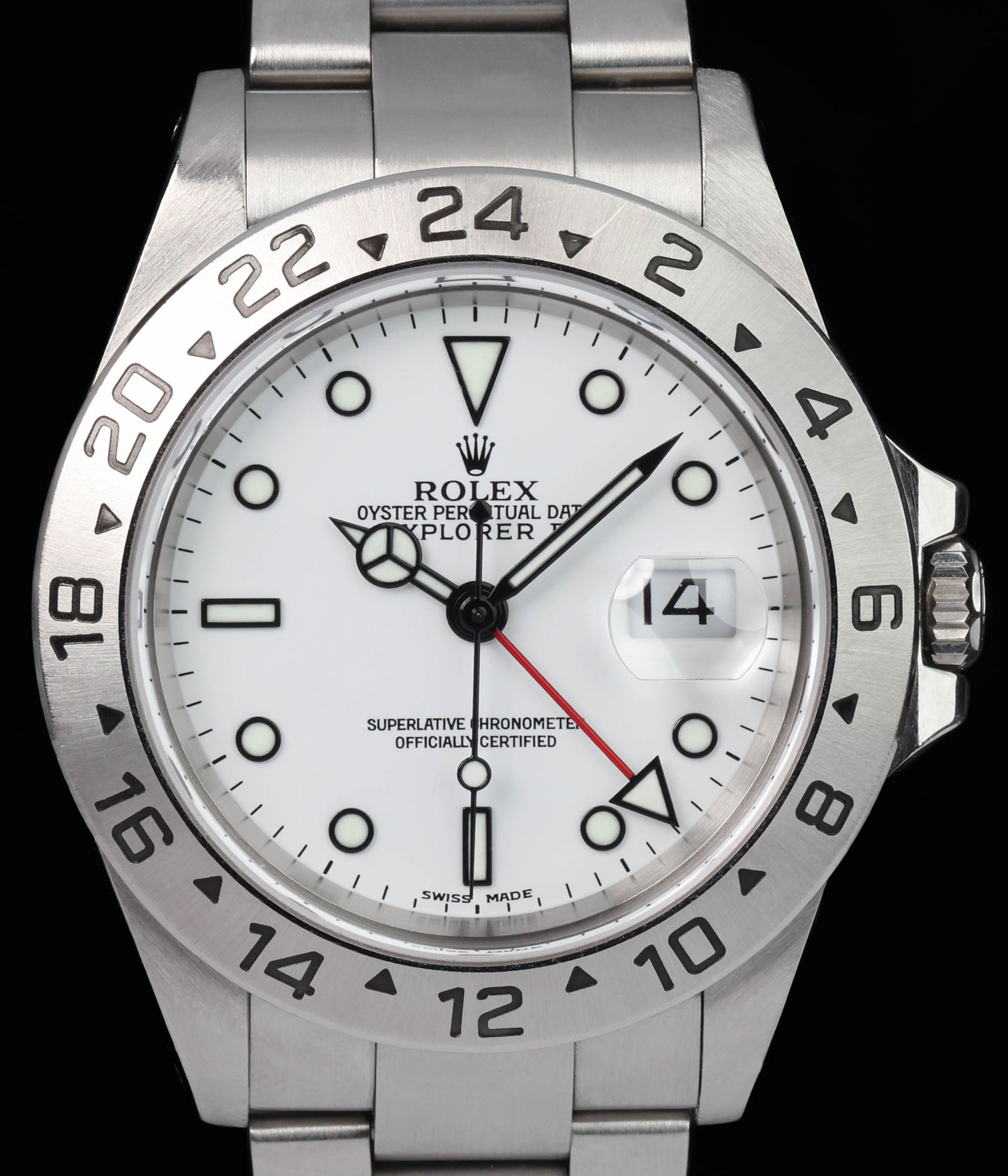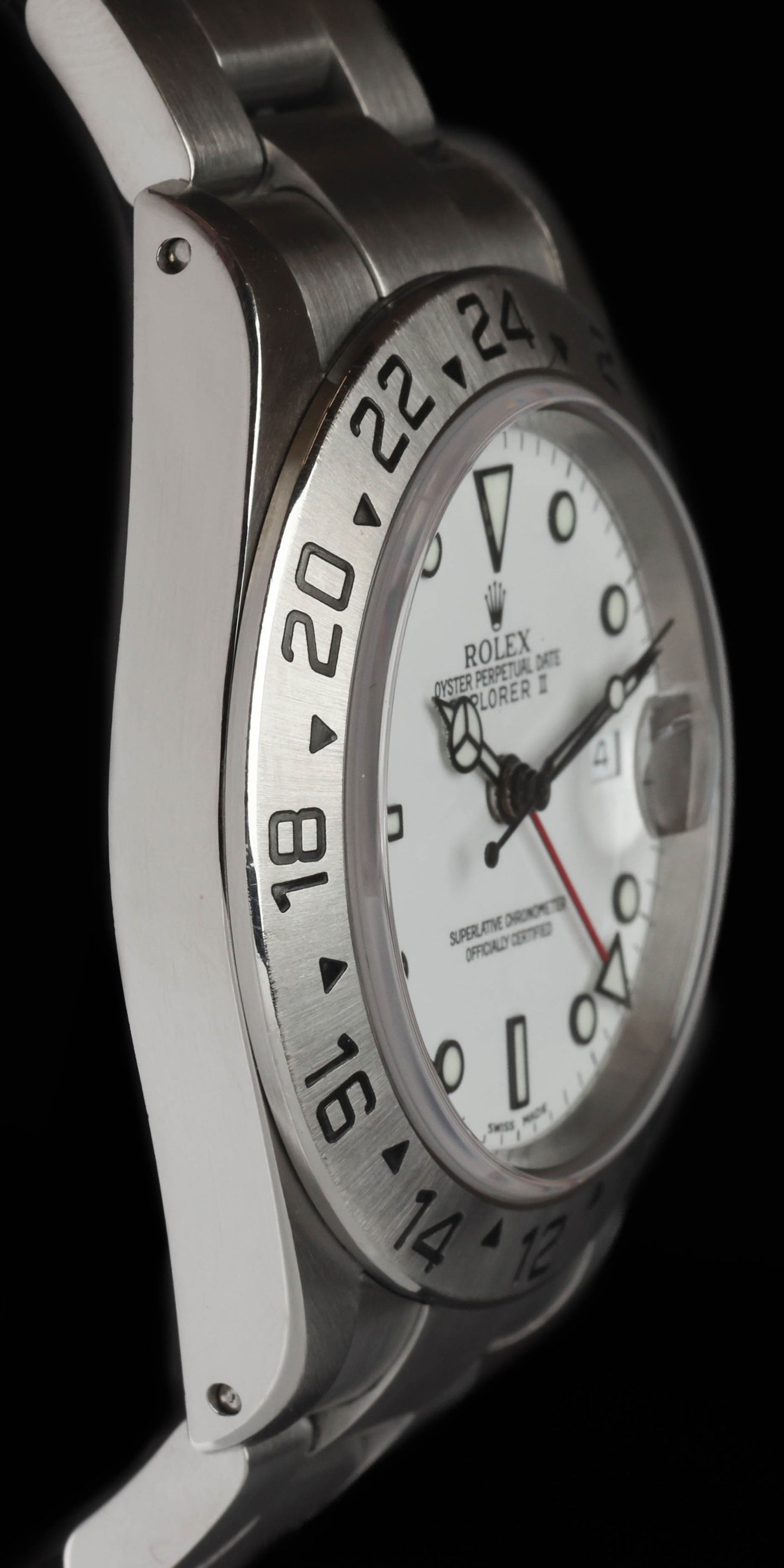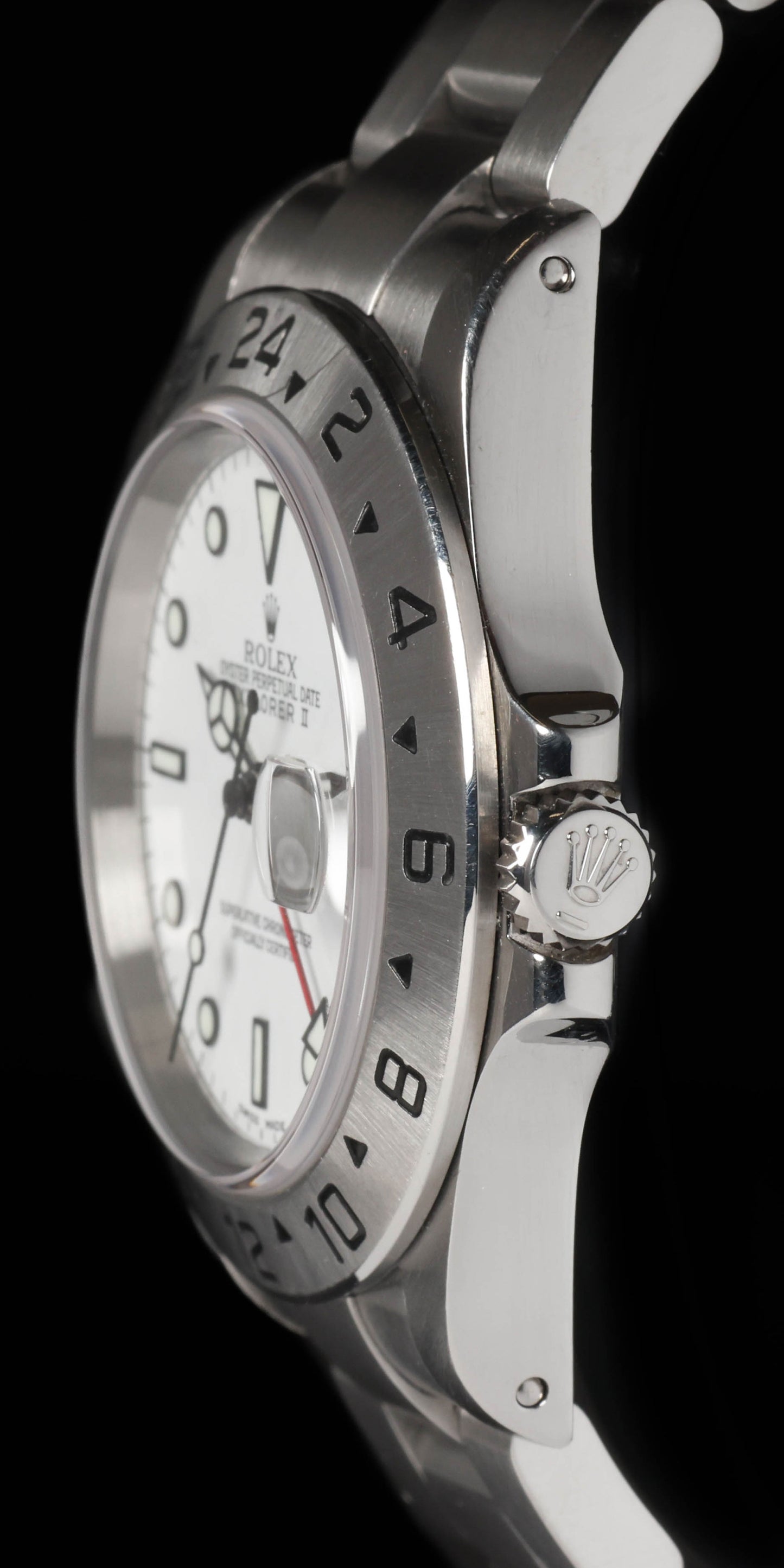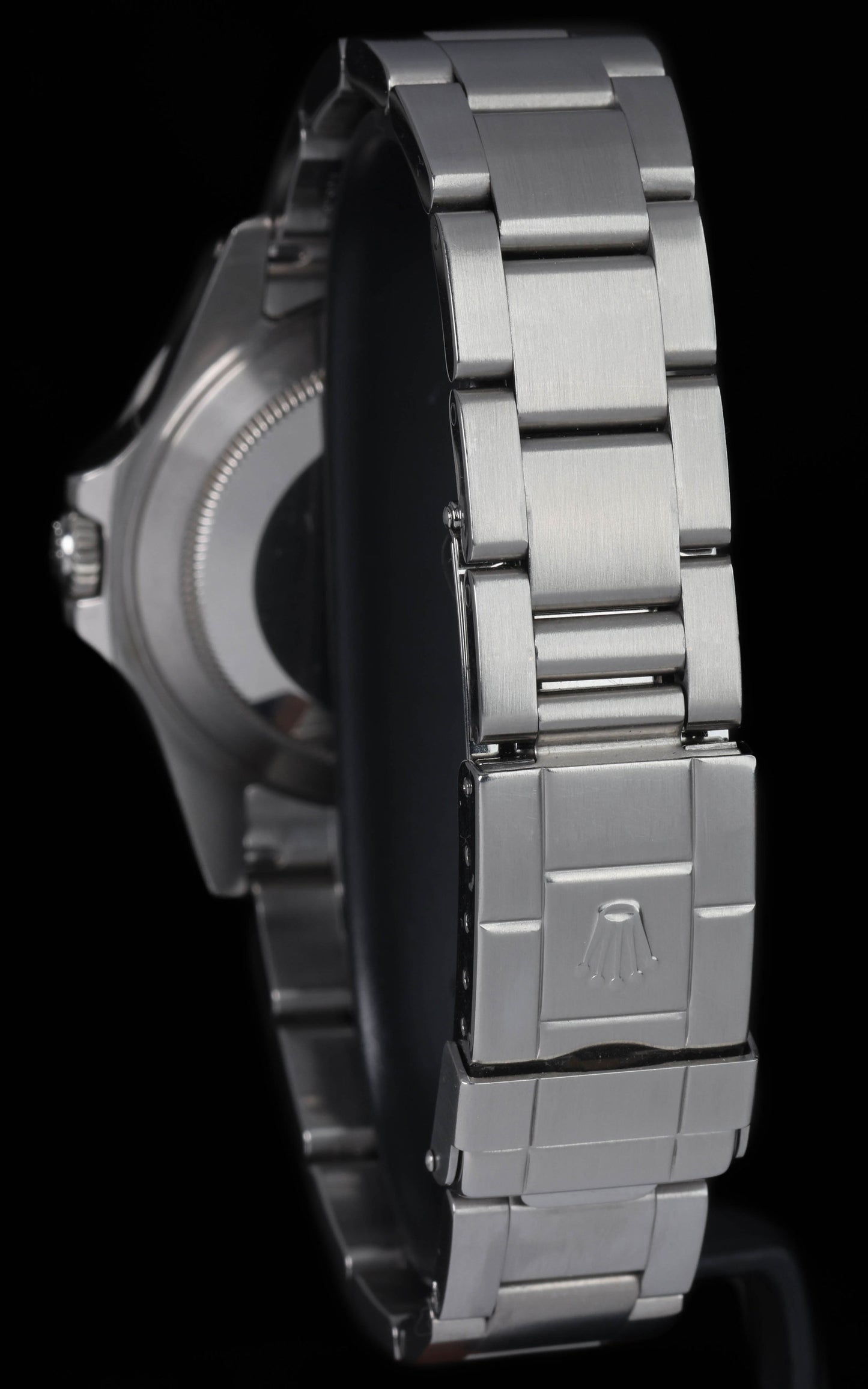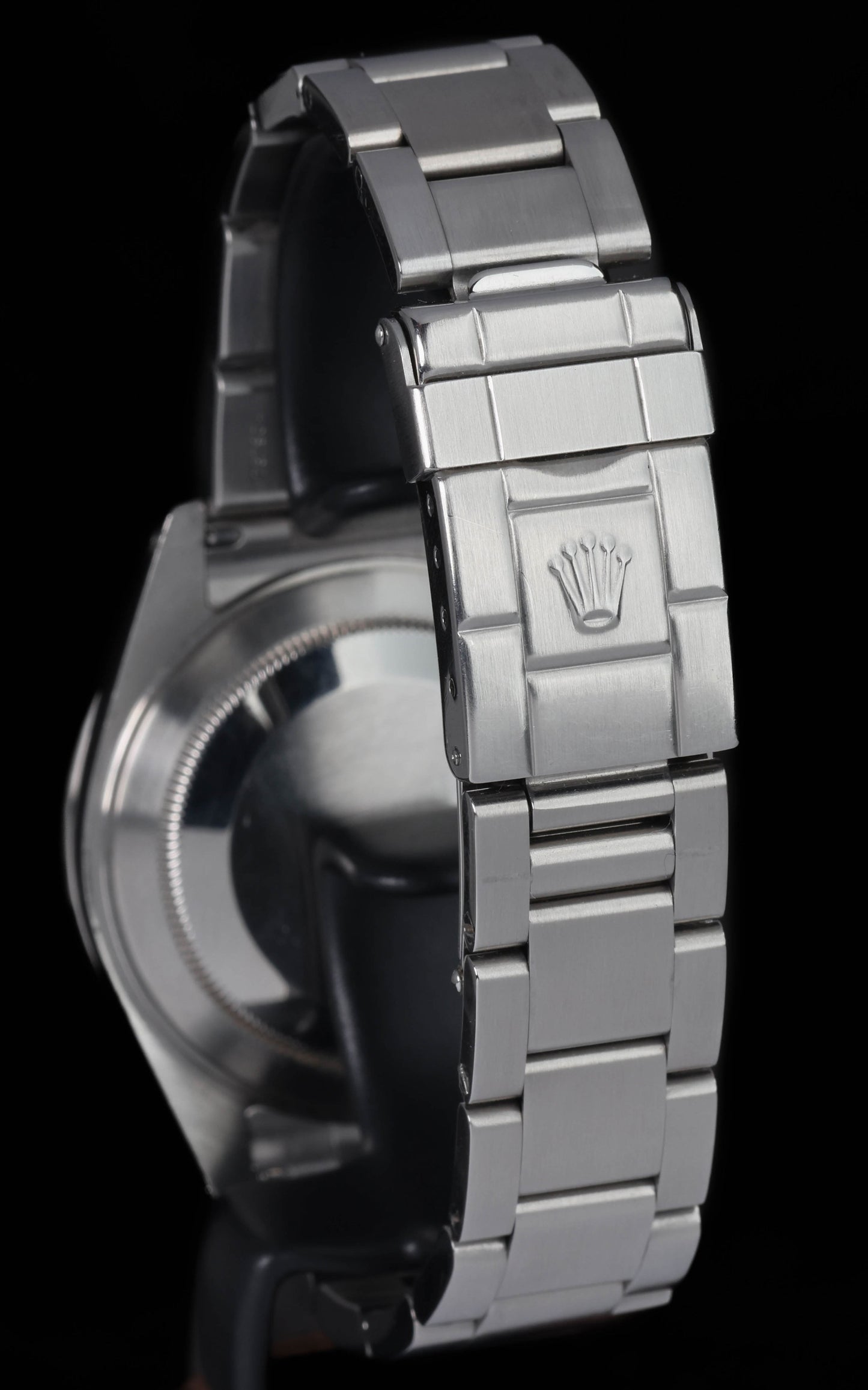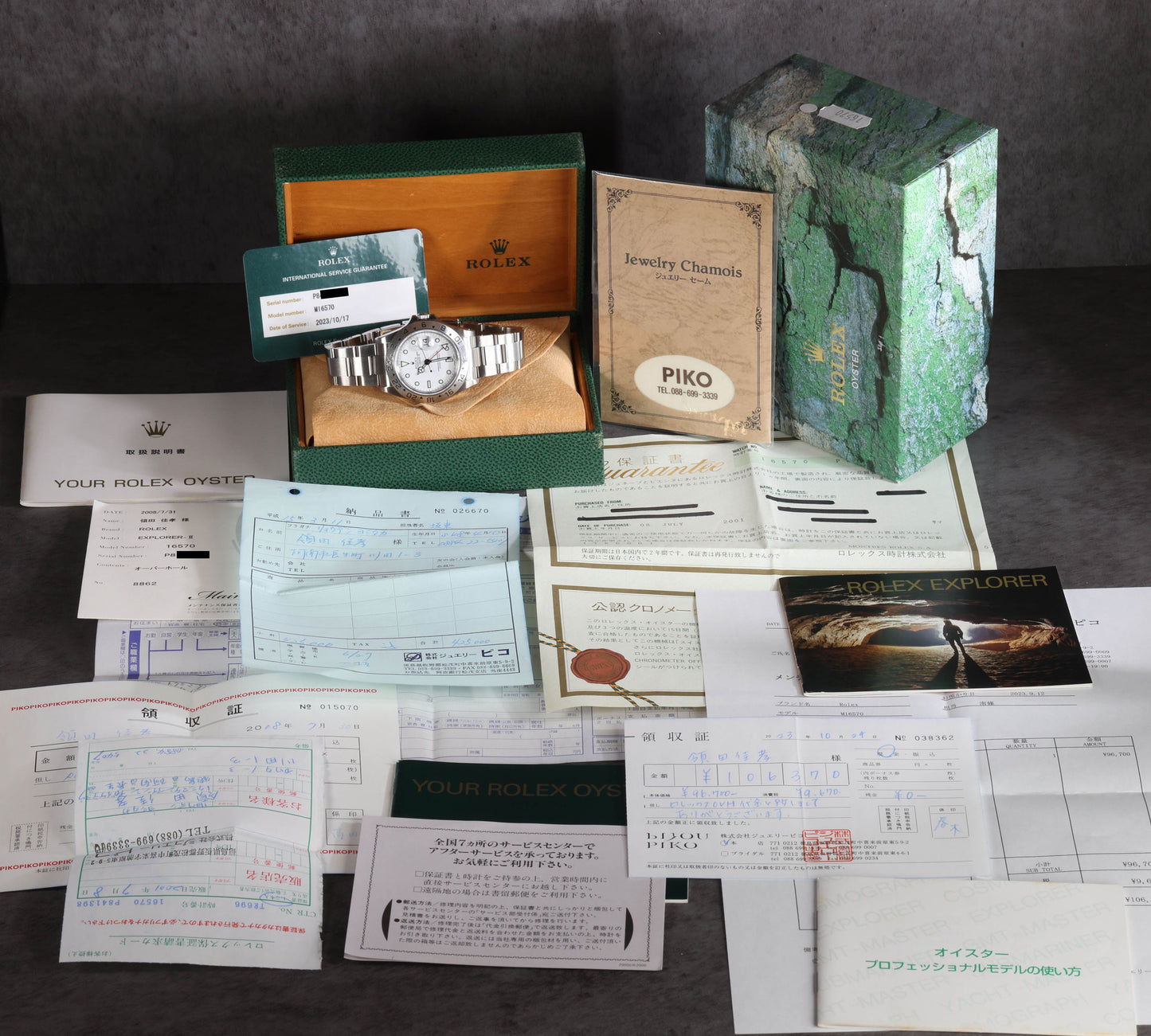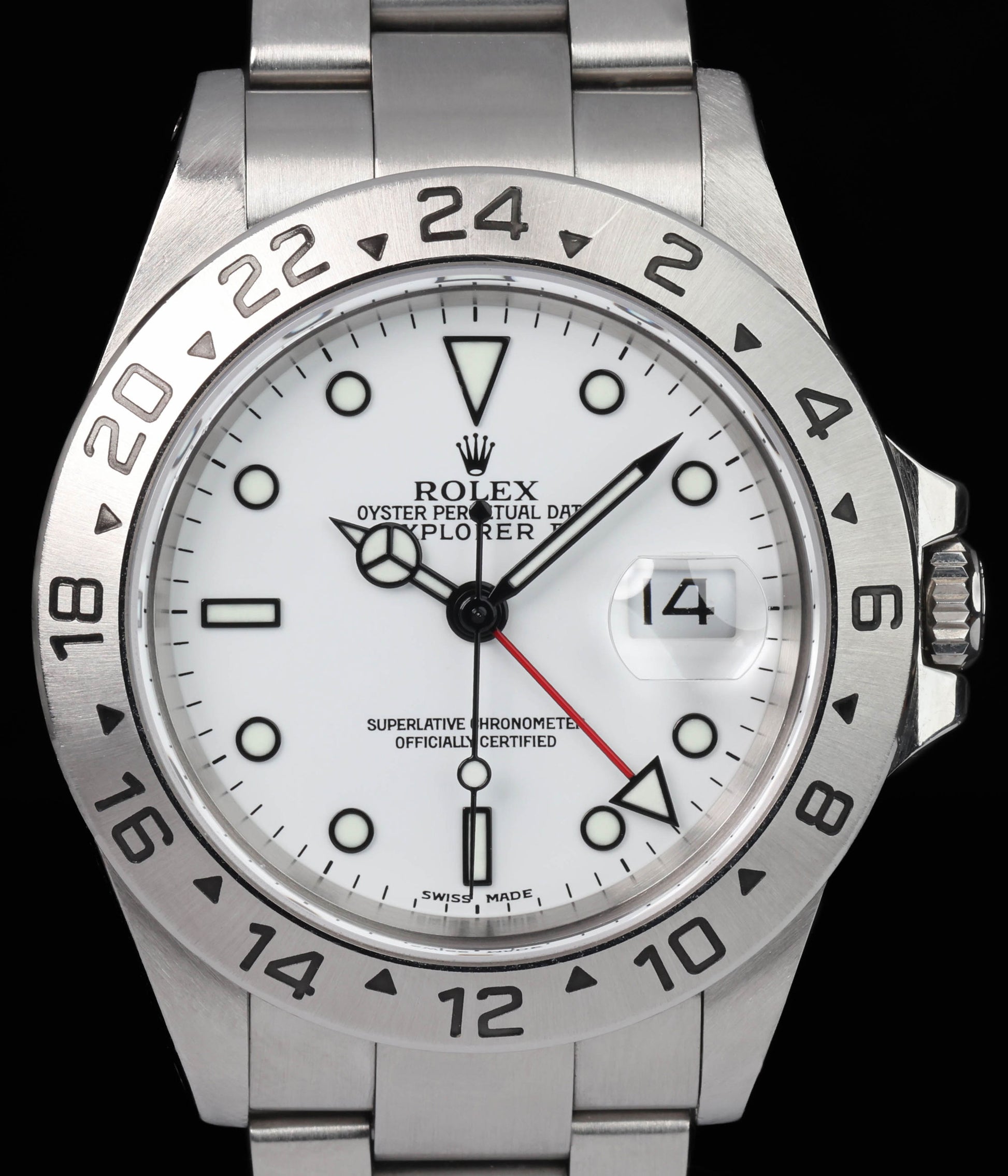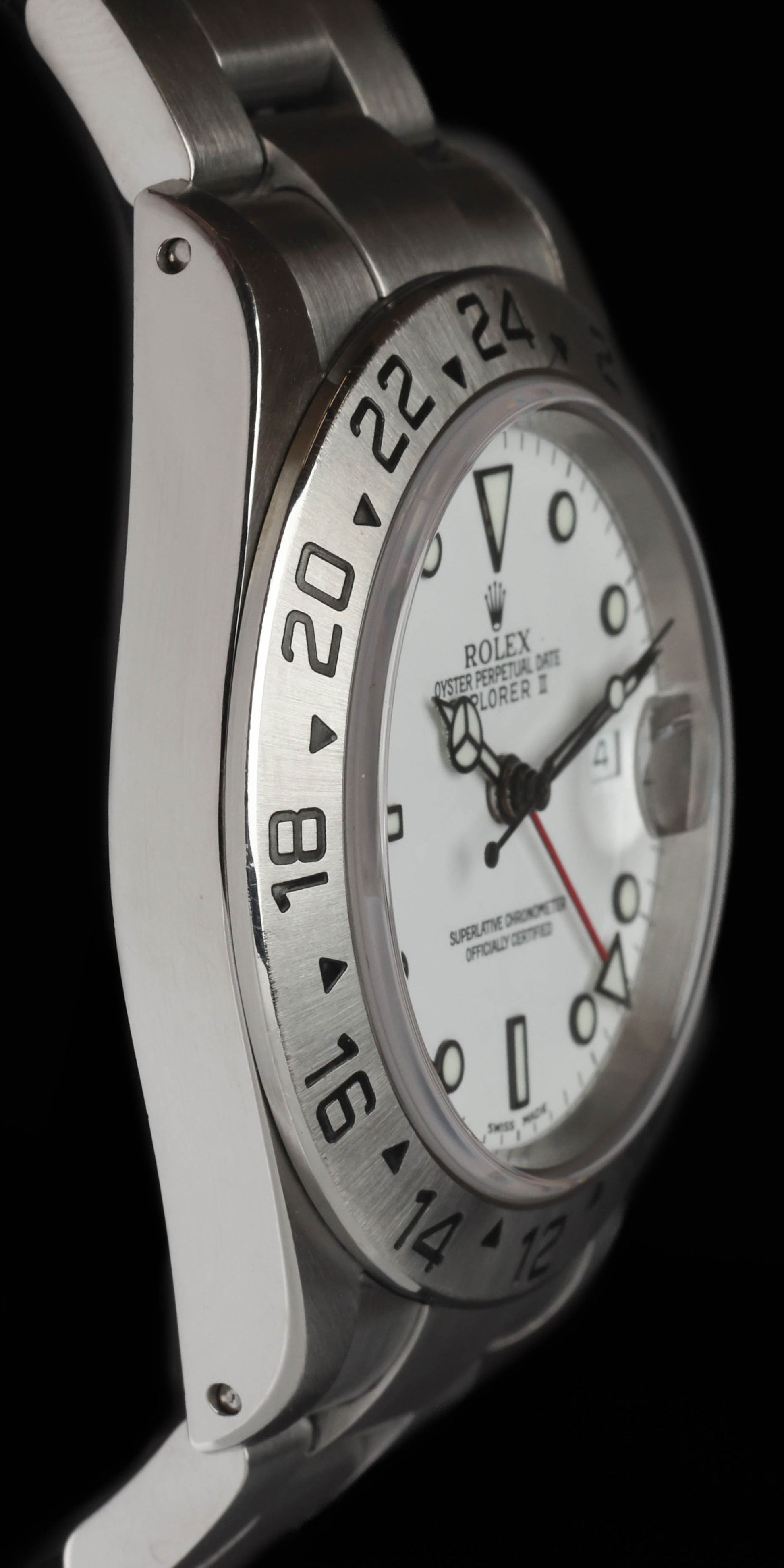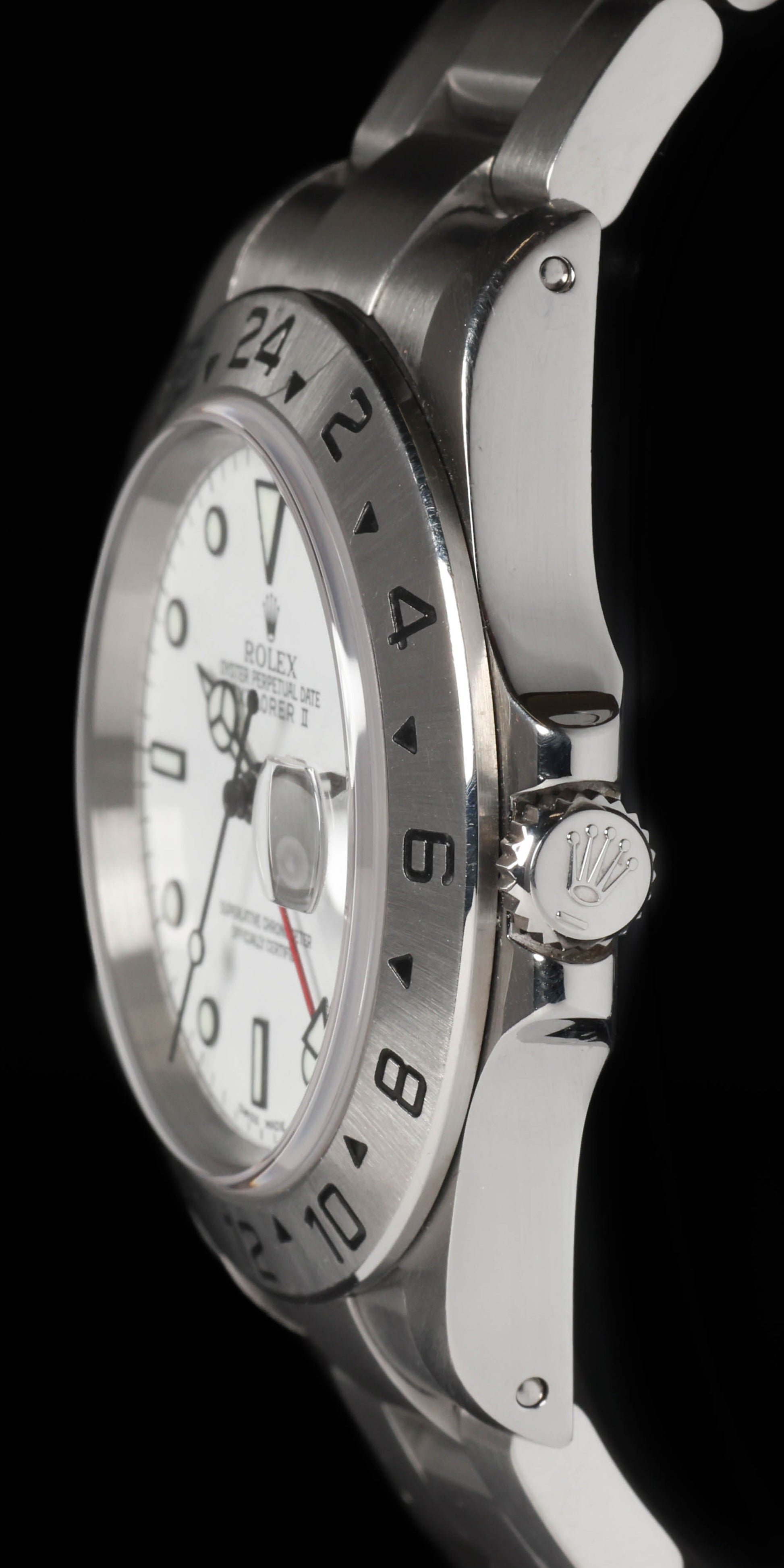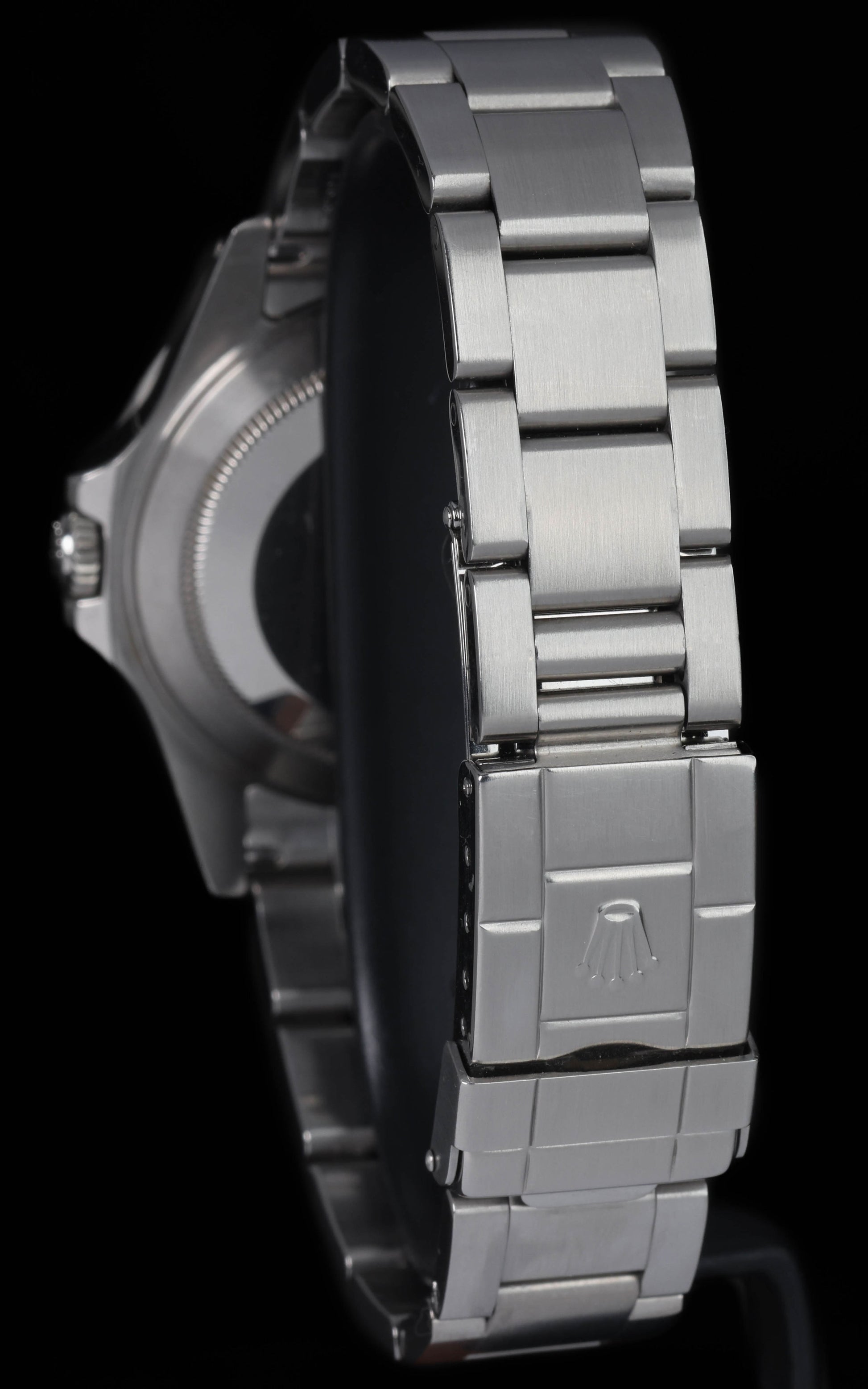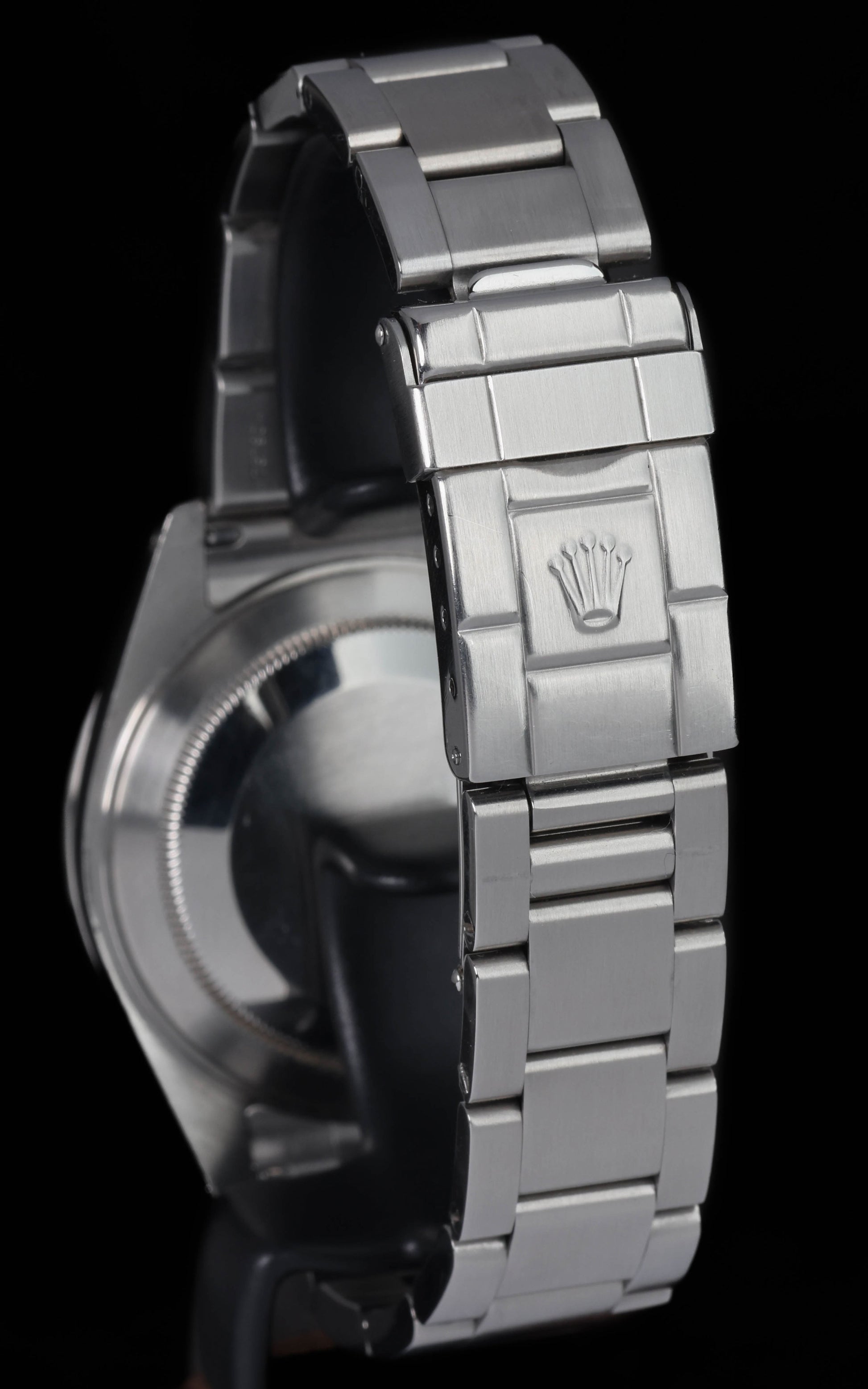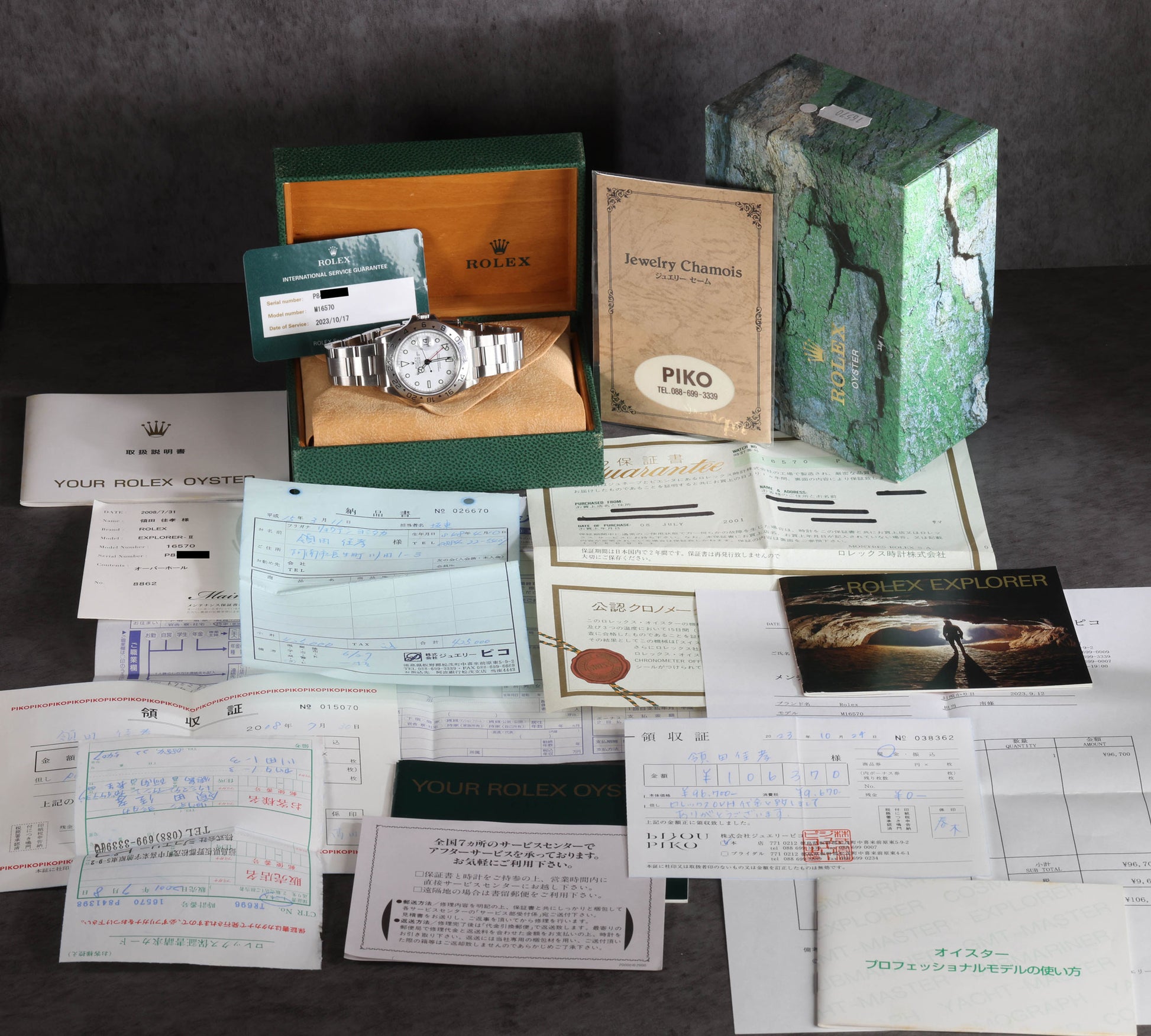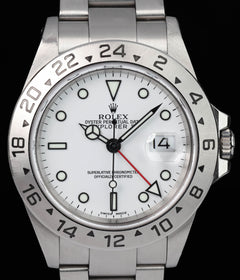Crown Vintage
Rolex Explorer II 16570 'Polar Dial' 40mm 2000 Box, Papers & Full Service History
Rolex Explorer II 16570 'Polar Dial' 40mm 2000 Box, Papers & Full Service History
Couldn't load pickup availability
Rolex Explorer II 16570 'Polar Dial'
The case and bracelet of this Rolex Explorer II 16570 remain in very good overall condition, with only minimal signs of wear visible to the naked eye. Light hairline scratches can be seen on close inspection, consistent with careful use over time. The stainless steel Oyster bracelet retains excellent structural integrity, exhibiting little to no stretch and maintaining a tight, secure fit. The fixed bezel remains sharp with all 24-hour engravings clearly defined. The dial and hands are flawless, with the crisp white “Polar” dial showing no signs of discolouration or blemishes. Hour markers and hands retain their original finish, and the luminous material remains intact and evenly applied. Overall, this is a well-preserved example of the reference, with strong case geometry, a tight bracelet, and a pristine dial presentation.
Share
Why we love this watch
Why we love this watch
Rolex Explorer II 16570 Polar Dial (2000): A Rugged Classic Refined
Introduction
The Rolex Explorer II 16570, especially with the crisp white “Polar” dial, is a distinctive and purpose-driven sports watch that stands apart from its more glamourised Rolex siblings. Introduced in 1989 and produced until around 2011, the 16570 marked the second generation of the Explorer II line, originally conceived in the 1970s for spelunkers and polar explorers. The 16570 represents a refined, more versatile evolution—especially in the year 2000, a period which saw Rolex refining case finishing, lume, and bracelet design without altering the core functionality of the reference.
In this in-depth look at the Rolex Explorer II 16570 from 2000, we explore its technical evolution, design hallmarks, and place within the wider Rolex sport model ecosystem. The Polar dial variant, with its sharp contrast between the stark white dial and black-outlined markers, brings a unique aesthetic that has since become iconic in its own right.
Evolution of the Explorer II
The Rolex Explorer II debuted in 1971 with the reference 1655. That model, also known as the “Steve McQueen” (incorrectly, as he never wore it), featured a bold 24-hour hand and fixed steel bezel. It was designed for cave explorers who needed to distinguish day from night while operating in complete darkness. Though functional and robust, the 1655 was ultimately a niche product.
In 1985, Rolex transitioned to the 16550, modernising the line with a larger 40mm case, applied markers with white gold surrounds, and the option of a white dial. The 16550 was short-lived, but laid the groundwork for the 16570, which entered production in 1989 and remained a mainstay for over two decades. By 2000, the reference had undergone subtle yet important refinements that solidified its appeal both as a tool watch and a daily wearer.
Case and Construction
The Explorer II 16570 maintains the classic 40mm Oyster case, crafted from 904L stainless steel—a corrosion-resistant alloy Rolex had already begun to employ across many of its professional models. The brushed finish on the lugs and case sides enhances the rugged aesthetic. The case thickness, at approximately 12.2mm, keeps it relatively slim compared to modern sports watches, allowing it to slide under a cuff easily while still offering substantial wrist presence.
The fixed 24-hour bezel is a defining feature of the Explorer II. Unlike the GMT-Master, the bezel is made from solid brushed steel and does not rotate. It is engraved with 24-hour numerals that pair with the GMT hand to track a second time zone or function as a fixed AM/PM indicator.
In the year 2000, the case finishing was particularly crisp. Sharp lug transitions, prominent chamfers, and factory brushing were all executed to Rolex’s exacting standards. Drilled lug holes were still present, making strap changes easier and underlining the watch’s tool watch heritage—a detail many enthusiasts miss in later no-hole cases.
Dial and Hands
The standout feature of the Polar 16570 is, of course, its dial. The white lacquer dial offers a clean, high-contrast aesthetic that makes the watch instantly recognisable. Black-outlined hour markers filled with luminous material ensure superb legibility. In 2000, Rolex was transitioning from tritium lume to Luminova. While earlier tritium dials aged into creamy tones, Luminova offered bright, lasting luminosity but retained the same visual style.
One key visual signature is the black surrounds on the hour markers and hands. The black Mercedes hour hand, black-outlined minute hand, and the vibrant red GMT hand with a large triangle tip all pop brilliantly against the white backdrop. This striking contrast gives the Polar 16570 its unique visual identity.
The date window at 3 o’clock is magnified by Rolex’s Cyclops lens on the sapphire crystal—standard on Oyster Perpetual Date models. The crystal itself is scratch-resistant and slightly raised above the bezel.
Movement and Functionality
The Explorer II 16570 from 2000 is powered by the Rolex calibre 3185, a workhorse GMT movement introduced in the late 1980s. It features a 28,800 bph beat rate, hacking seconds, and quickset GMT functionality. Unlike the GMT-Master II, which allows for the independent adjustment of the 24-hour hand, the Explorer II’s second time zone is tracked by jumping the local hour hand forward or back in one-hour increments.
The calibre 3185 is known for its robust construction and reliable timekeeping. It incorporates a free-sprung balance wheel with Breguet overcoil and Rolex’s KIF shock protection system. The movement was chronometer-certified (COSC), meaning it passed rigorous testing for accuracy in various positions and temperatures.
By the early 2000s, Rolex had refined the 3185 to offer smoother hand adjustment and tighter tolerances across the board. While the later 3186 movement (introduced around 2006) brought a few upgrades including a Parachrom hairspring, many still regard the 3185 as one of the brand’s most dependable and long-lived movements.
Bracelet and Wearability
The 16570 comes fitted with the Oyster bracelet featuring solid outer links and solid end links. The bracelet retains the brushed finish across all links, aligning with the tool watch ethos. The clasp is a stamped steel fold-over design with the Rolex coronet—a design that would later be modernised, but in this period, remained simple and lightweight.
In 2000, the bracelet design was transitioning in quality and finishing, but still retained older hallmarks like slightly jangly feel and stamped clasp blades. While not as solid as modern Rolex bracelets, the construction is robust and comfortable. The watch wears flat and comfortably thanks to the relatively thin case profile and low centre of gravity.
On the wrist, the 40mm case with short lugs makes it wearable across a wide range of wrist sizes. The Polar dial creates the illusion of slightly more wrist presence, given the light tone and crisp contrast, making it more noticeable than its black-dial counterpart.
Tool Watch Utility Meets Versatility
One of the Explorer II’s defining characteristics is its original intended use for speleologists and explorers operating in environments where the distinction between day and night is irrelevant. The fixed 24-hour bezel and the ability to track two time zones made it ideal for such conditions. Over time, its practicality and understated aesthetic have made it a popular choice among those wanting a GMT watch that flies under the radar.
The Polar dial, in particular, adds a versatility not often found in Rolex’s more common black-dial sports watches. It works well dressed down or paired with smart casual attire, standing out without being loud. It’s also one of the few Rolex sport models with a white dial, giving it a unique space in the professional range.
Notable Design Continuity
Despite being a second-generation model, the 16570 retained the fixed steel bezel—remaining faithful to the original 1655 design ethos. This sets the Explorer II apart from the GMT-Master line, which has always featured rotating bezels. For some, this adds a certain purity to its intended function.
There were no Rolesor or precious metal variants of the 16570, a decision that kept the watch aligned with its rugged tool watch DNA. In an era when Rolex was beginning to expand its use of ceramic bezels and polished centre links across the sport range, the Explorer II remained relatively unchanged, preserving its original identity until its eventual replacement by the beefier 216570 in 2011.
Final Thoughts
The Rolex Explorer II 16570 Polar from 2000 sits at a compelling intersection of vintage feel and modern reliability. It features a clean, highly legible design, a robust case with wearable proportions, and one of the most practical GMT configurations available from the brand.
This particular era—with Luminova lume, drilled lugs, and the 3185 calibre—offers a snapshot of Rolex in transition. Before the maxi-case era and the rise of ceramic, there was still a clear separation between professional tool watches and luxury statements. The 16570, especially with the Polar dial, embodies that balance with clarity and confidence.
With its timeless 40mm case, stark white dial, and independent hour hand functionality, the Explorer II 16570 Polar remains one of Rolex’s most quietly capable and distinctive offerings. It’s a watch that continues to prove itself—whether trekking across time zones or simply standing out in a world full of black dials and polished bezels.
Case & Bracelet
Case & Bracelet
Case and bracelet in very good condition. Minimal wear visible. Light hairlines visible. Bracelet has little to no stretch.
Dial & Hands
Dial & Hands
Dial & hands flawless.
Warranty & Condition
Warranty & Condition
Crown Vintage Watches provides a minimum 3-month mechanical warranty on pre-owned watches, from the date of purchase.
The warranty covers mechanical defects only.
The warranty does not cover damages such as scratches, finish, crystals, glass, straps (leather, fabric or rubber damage due to wear and tear), damage resulting from wear under conditions exceeding the watch manufacturer’s water resistance limitations, and damage due to physical and or accidental abuse.
Please note, water resistance is neither tested nor guaranteed.
Shipping and insurance costs for warranty returns to us must be covered by the customer. Returns must be shipped via traceable courier. Return shipment must be pre-paid and fully insured. Collect shipping will be refused. In case of loss or damages, the customer is liable.
Our Pledge
At Crown Vintage Watches, we stand by the authenticity of every product we sell. For added peace of mind, customers are welcome to have items independently authenticated at their own expense.
Condition
Due to the nature of vintage timepieces, all watches are sold as is. We will accurately describe the current condition and working order of all watches we sell to the best of our ability.
Shipping & Refund
Shipping & Refund
